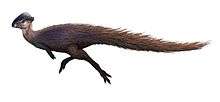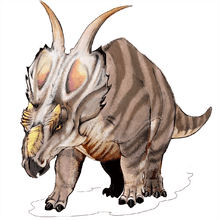Utahceratops
| Utahceratops Temporal range: Late Cretaceous, 76.4–75.5 Ma | |
|---|---|
 | |
| Selected craniofacial elements of Utahceratops gettyi | |
| Scientific classification | |
| Kingdom: | Animalia |
| Phylum: | Chordata |
| Class: | Reptilia |
| Clade: | Dinosauria |
| Order: | †Ornithischia |
| Family: | †Ceratopsidae |
| Subfamily: | †Chasmosaurinae |
| Genus: | †Utahceratops Sampson et al., 2010 |
| Species: | †U. gettyi |
| Binomial name | |
| Utahceratops gettyi Sampson et al., 2010 | |
Utahceratops (meaning "Utah κέρας (keras, "horn") and ὤψ (ōps, "face"))") is an extinct genus of ceratopsian dinosaur that lived approximately 76.4~75.5 million years ago during the Late Cretaceous period in what is now Utah. Utahceratops was a large-sized, robustly-built, ground-dwelling, quadrupedal herbivore, that could grow up to an estimated 7 m (23 ft) long.
Etymology

The genus name Utahceratops, means "horned face from Utah", and is derived from the state of Utah and Greek words "keras" (κέρας) meaning "horn" and "ops" (ὤψ) referring to the "face".[1] The specific name gettyi, is derived from the name of Mike Getty, who discovered the holotype and has played a pivotal role in the recovery of fossils from the Grand Staircase-Escalante National Monument (GSENM). It was first named by Scott D. Sampson, Mark A. Loewen, Andrew A. Farke, Eric M. Roberts, Catherine A. Forster, Joshua A. Smith and Alan L. Titus in 2010, and the type species is Utahceratops gettyi.[2]
Description
The holotype specimen UMNH VP 16784, consists of only a partial skull. This genus is known from six specimens, including two partial skulls, which when taken together preserve about 96% of the skull and 70% of the postcranial skeleton. Utahceratops are estimated to have measured on average 2 metres (6.6 feet) in height, 6 to 7 meters (19.7 to 23 feet) in length, and between three and four metric tons in weight.[3]
Phylogeny


Utahceratops has been classified as a basal chasmosaurine ceratopsian. It has been found to be in a clade of basal chasmosaurines with Pentaceratops.[2]
The below cladogram follows Longrich (2014), who named a new species of Pentaceratops, and included nearly all species of chasmosaurine.[4]
| Chasmosaurinae |
| |||||||||||||||||||||||||||||||||||||||||||||||||||||||||||||||||||||||||||||||||||||||||||||||||||||||||||||||||||||||||||||||||
| |
Distinguishing anatomical features
According to Sampson et al. (2010), Utahceratops can be distinguished based on the following characteristics: the nasal horncore is caudally positioned, almost entirely behind external naris; the supraorbital horncores are short, robust, dorsolaterally directed, and oblate in shape with a blunt tip; the episquamosals on the mid-portion of the lateral frill margin are low and extremely elongate (some >10 cm long); and the median portion of transverse bar of the parietal bone is rostrally curved.[2]
Paleoecology
Habitat

The only known specimen of Utahceratops was recovered at the Kaiparowits Formation, in Utah.[2] Argon-argon radiometric dating indicates that the Kaiparowits Formation was deposited between 76.6 and 74.5 million years ago, during the Campanian stage of the Late Cretaceous period.[5][6] During the Late Cretaceous period, the site of the Kaiparowits Formation was located near the western shore of the Western Interior Seaway, a large inland sea that split North America into two landmasses, Laramidia to the west and Appalachia to the east. The plateau where dinosaurs lived was an ancient floodplain dominated by large channels and abundant wetland peat swamps, ponds and lakes, and was bordered by highlands. The climate was wet and humid, and supported an abundant and diverse range of organisms.[7] This formation contains one of the best and most continuous records of Late Cretaceous terrestrial life in the world.[8]
Paleofauna
Utahceratops shared its paleoenvironment with other dinosaurs, such as dromaeosaurid theropods , the troodontid Talos sampsoni, tyrannosaurids like Teratophoneus, armored ankylosaurids, the duckbilled hadrosaurs Parasaurolophus cyrtocristatus and Gryposaurus monumentensis, the ceratopsians Nasutoceratops titusi and Kosmoceratops richardsoni and the oviraptorosaurian Hagryphus giganteus.[9] Some fossil evidence suggests the presence of the tyrannosaurid Albertosaurus and the ornithomimid Ornithomimus velox, but the existing assessment of the material is not conclusive. Paleofauna present in the Kaiparowits Formation included chondrichthyans (sharks and rays), frogs, salamanders, turtles, lizards and crocodilians. A variety of early mammals were present including multituberculates, marsupials, and insectivorans.[10]
See also
References
- ↑ Liddell, Henry George and Robert Scott (1980). A Greek-English Lexicon (Abridged Edition). United Kingdom: Oxford University Press. ISBN 0-19-910207-4.
- 1 2 3 4 Sampson, S. D.; Loewen, M. A.; Farke, A. A.; Roberts, E. M.; Forster, C. A.; Smith, J. A.; Titus, A. L. (2010). Stepanova, Anna, ed. "New Horned Dinosaurs from Utah Provide Evidence for Intracontinental Dinosaur Endemism". PLoS ONE. 5 (9): e12292. doi:10.1371/journal.pone.0012292. PMC 2929175
 . PMID 20877459.
. PMID 20877459. - ↑ "Descubren nuevos dinosaurios con cuernos" [New dinosaurs with horns have been discovered]. La Nación (in Spanish). 26 September 2010.
- ↑ Longrich, N. R. (2014). "The horned dinosaurs Pentaceratops and Kosmoceratops from the upper Campanian of Alberta and implications for dinosaur biogeography". Cretaceous Research. 51: 292. doi:10.1016/j.cretres.2014.06.011.
- ↑ Roberts EM, Deino AL, Chan MA (2005) 40Ar/39Ar age of the Kaiparowits Formation, southern Utah, and correlation of contemporaneous Campanian strata and vertebrate faunas along the margin of the Western Interior Basin. Cretaceous Res 26: 307–318.
- ↑ Eaton, J.G., 2002. Multituberculate mammals from the Wahweap(Campanian, Aquilan) and Kaiparowits (Campanian, Judithian) formations, within and near Grand Staircase-Escalante NationalMonument, southern Utah. Miscellaneous Publication 02-4, UtahGeological Survey, 66 pp.
- ↑ Titus, Alan L. and Mark A. Loewen (editors). At the Top of the Grand Staircase: The Late Cretaceous of Southern Utah. 2013. Indiana University Press. Hardbound: 634 pp.
- ↑ Clinton, William. "Preisdential Proclamation: Establishment of the Grand Staircase-Escalante National Monument". September 18, 1996. Retrieved 9 November 2013.
- ↑ Zanno, Lindsay E.; Sampson, Scott D. (2005). "A new oviraptorosaur (Theropoda; Maniraptora) from the Late Cretaceous (Campanian) of Utah". Journal of Vertebrate Paleontology. 25 (4): 897–904. doi:10.1671/0272-4634(2005)025[0897:ANOTMF]2.0.CO;2.
- ↑ Eaton, Jeffrey G.; Cifelli, Richard L.; Hutchinson, J. Howard; Kirkland, James I.; Parrish, J. Michael (1999). "Cretaceous vertebrate faunas from the Kaiparowits Plateau, south-central Utah". In Gillete, David D. (ed.). Vertebrate Paleontology in Utah. Miscellaneous Publication 99-1. Salt Lake City: Utah Geological Survey. pp. 345–353. ISBN 1-55791-634-9.


